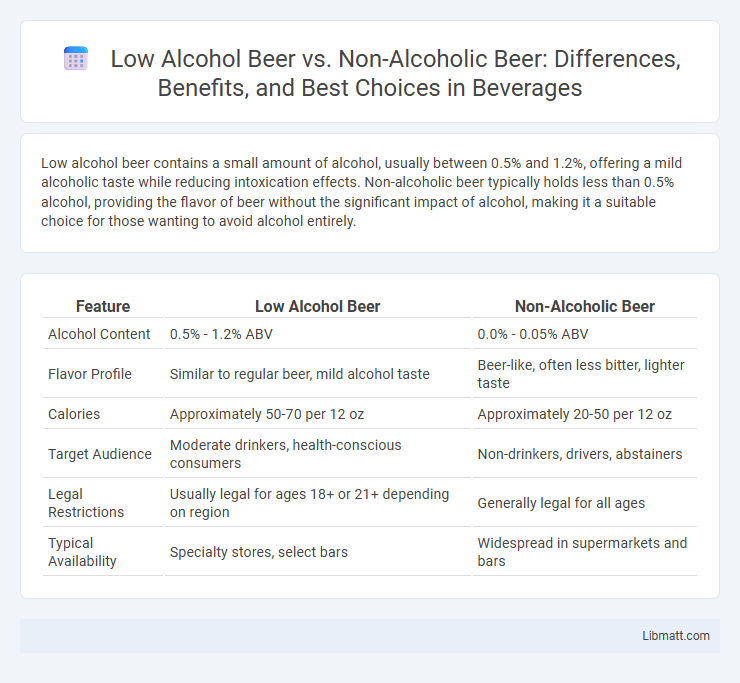Low alcohol beer contains a small amount of alcohol, usually between 0.5% and 1.2%, offering a mild alcoholic taste while reducing intoxication effects. Non-alcoholic beer typically holds less than 0.5% alcohol, providing the flavor of beer without the significant impact of alcohol, making it a suitable choice for those wanting to avoid alcohol entirely.
Table of Comparison
| Feature | Low Alcohol Beer | Non-Alcoholic Beer |
|---|---|---|
| Alcohol Content | 0.5% - 1.2% ABV | 0.0% - 0.05% ABV |
| Flavor Profile | Similar to regular beer, mild alcohol taste | Beer-like, often less bitter, lighter taste |
| Calories | Approximately 50-70 per 12 oz | Approximately 20-50 per 12 oz |
| Target Audience | Moderate drinkers, health-conscious consumers | Non-drinkers, drivers, abstainers |
| Legal Restrictions | Usually legal for ages 18+ or 21+ depending on region | Generally legal for all ages |
| Typical Availability | Specialty stores, select bars | Widespread in supermarkets and bars |
Defining Low Alcohol Beer and Non-Alcoholic Beer
Low alcohol beer typically contains between 0.5% and 1.2% alcohol by volume (ABV), offering a mild alcoholic taste with reduced intoxication effects compared to regular beer. Non-alcoholic beer generally contains less than 0.5% ABV, often brewed to closely mimic the flavor of traditional beer without significant alcohol content. Your choice between the two depends on whether you prefer a slight alcohol presence or an alcohol-free experience while enjoying the taste of beer.
Legal Alcohol Content: Key Differences
Low alcohol beer typically contains between 0.5% and 3.5% alcohol by volume (ABV), whereas non-alcoholic beer must have an ABV of 0.5% or less according to legal standards in many countries. The legal distinction hinges on ABV thresholds that influence labeling, taxation, and purchase regulations. Understanding these precise alcohol content limits is crucial for consumers navigating legal restrictions and personal preferences.
Production Processes Compared
Low alcohol beer and non-alcoholic beer differ significantly in their production processes, with low alcohol beer typically brewed using traditional methods but stopping fermentation early to limit alcohol content, whereas non-alcoholic beer undergoes a process to remove alcohol after full fermentation, such as vacuum distillation or reverse osmosis. The careful control in low alcohol beer aims to retain more of the original flavor compounds, while non-alcoholic beer production focuses on preserving taste despite the alcohol removal step. Your choice may depend on whether you prioritize a closer taste to regular beer or minimal alcohol presence.
Taste and Flavor Profiles
Low alcohol beer typically retains more of the traditional malt sweetness, hop bitterness, and complex flavor notes found in regular beer, offering a richer taste experience. Non-alcoholic beer often has a lighter body and may exhibit subtle off-flavors or a slightly sweeter profile due to the alcohol removal process, which can affect balance and mouthfeel. Your choice between the two depends on whether you prioritize authentic beer flavor with minimal alcohol or a beverage with virtually no alcohol content but a milder taste.
Health Benefits and Considerations
Low alcohol beer contains a small percentage of alcohol, typically up to 1.2%, which may provide some cardiovascular benefits similar to moderate alcohol consumption, such as improved heart health and reduced risk of certain diseases. Non-alcoholic beer offers hydration and essential nutrients like vitamins and antioxidants without the risks associated with alcohol, making it a safer option for those avoiding intoxication or alcohol-related health issues. Your choice between the two should consider individual health goals, alcohol tolerance, and any medical conditions requiring abstinence from alcohol.
Social and Cultural Perceptions
Low alcohol beer is often perceived as a compromise for social drinkers seeking moderation, maintaining traditional beer flavors with minimal intoxication. Non-alcoholic beer, while gaining acceptance, sometimes faces stigma as a "healthier" or less authentic alternative, impacting its cultural status in beer-centric communities. Both options reflect evolving attitudes toward responsible drinking and inclusion in social settings where alcohol consumption is customary.
Calorie Count and Nutritional Information
Low alcohol beer typically contains 0.5% to 1.2% alcohol by volume and has around 50-100 calories per 12-ounce serving, with moderate carbohydrates and sugars depending on the brand. Non-alcoholic beer generally contains less than 0.5% alcohol and tends to have fewer calories, often ranging from 50-70 calories per 12-ounce serving, with lower sugar content and reduced carbohydrate levels compared to low alcohol options. Understanding the calorie count and nutritional information helps you make an informed choice based on your dietary goals and preferences.
Best Uses and Occasions for Each
Low alcohol beer, containing up to 3.5% ABV, is ideal for social gatherings and casual drinking where mild intoxication is acceptable, such as barbecues, sports events, or after-work meetups. Non-alcoholic beer, with less than 0.5% ABV, suits situations requiring sobriety or mindfulness, including driving, pregnancy, or workplace environments. Both offer versatile taste experiences but cater to different needs based on alcohol content and occasion suitability.
Market Trends and Consumer Preferences
Low alcohol beer and non-alcoholic beer markets are experiencing rapid growth, driven by increasing consumer demand for healthier lifestyle choices and moderation in alcohol consumption. Market trends indicate a rising preference for flavorful options with lower alcohol content, appealing to younger demographics and wellness-conscious consumers. Your choice between these beverages often depends on taste preferences and occasions, with low alcohol beers offering a closer experience to traditional beer and non-alcoholic variants catering to those seeking zero alcohol intake.
Choosing the Right Option for You
Low alcohol beer typically contains 0.5% to 1.2% alcohol by volume, offering a mild buzz with fewer calories compared to regular beer, while non-alcoholic beer contains less than 0.05% alcohol, making it ideal for those avoiding alcohol entirely. Consider personal health goals, taste preferences, and social contexts when choosing between low alcohol and non-alcoholic beer, as low alcohol beer provides a closer flavor profile to traditional beer. Individuals prioritizing sobriety or avoiding alcohol for medical reasons often find non-alcoholic beer to be a safer and more suitable choice.
Low alcohol beer vs non-alcoholic beer Infographic

 libmatt.com
libmatt.com